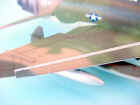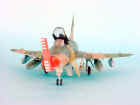|
In May 1953, as a proof of its self assurance and trust in its design, the North American made the first flight of the YF100 three months before it was approved by the Air Force, thus being the first flight of the first series plane (there were no prototypes).
This model belonged to one of the most famous aviation families of the USAF, the "Century" series. It obtained the last subsonic record, the first supersonic record and was the first supersonic fighter in the world and soon became obsolete before the end of its construction process.
A total of 2294 planes were built and the fire baptism was in June 1964 in Laos. They made more than 360.000 operative flights over Vietnam until they were removed from South East Asia in June 1971 (during this period only 243 planes were lost).
The last operative flight took place in November 1979 with the National Guard (some of the exported planes remained operative until the early 80's).
A direct descendant from the P51 Mustang and the F86 Sabre, this F100 Super Sabre or "Hun" - the first supersonic fighter - mainly acted as a ground attack and close support aircraft. Even in this situation it showed that it was an honorable heir to this important family.
The kit
I worked with the Esci F100D kit, detailed with the photoetched set from Eduard, also recommended for the Italeri kit. The only hard task here was to cut the cockpit, which comes as a single part and can suffer minor fractures (which can be enlarged if not carefully handled) The rest of the construction was relatively easy since the photoetched parts can easily be added and all details are correct.
|
I cut the flaps and slats and recreated them in scratch and using the cut out parts. By using the same technique I also produced the slat interior, the inner leading edge and the slat guides. In order to insert the stabilizers in a "dropped" position, I cut the original "tabs" from the mould, filled the tab holes and produced new shafts with hypodermic needles.
|

|
The seat is certainly one of the weaknesses of this kit, but you can produce a good replacement in scratch and with the use of the photoetched set.
After this simple construction stage, where filler was not used at all, I got to the painting stage. I decided to paint the model with the traditional paint scheme used in Vietnam and used as a reference a picture of a plane based in Bien Hoa.
I used Molak enamels, with the exception of "Camouflage Gray FS 36622" clears from Model Masters. In order to give it a "weathered" aspect, I used tints sepias and tan earth. I achieved a good weathered aspect in the turbine area by applying aluminum, then camouflage and finally sanding until the aluminum color emerged.
|
The air intake cover was produced with plastic sheet (the original intake of this kit was not deep enough and really demerit el end job). I bent the pitot tube and produced its protection (Remove before flight) with aluminum foil. I used the Hasegawa ground attack set to represent the weapons set.
|

|
For final detailing I used some extra decals taken from other kits and Super Scale set, applying letters and numbers one by one.
Bibliography
"North American F-100 Super Sabre" de Osprey Air Combat
"Enciclopedia Ilustrada de la Aviación N* 57"
|